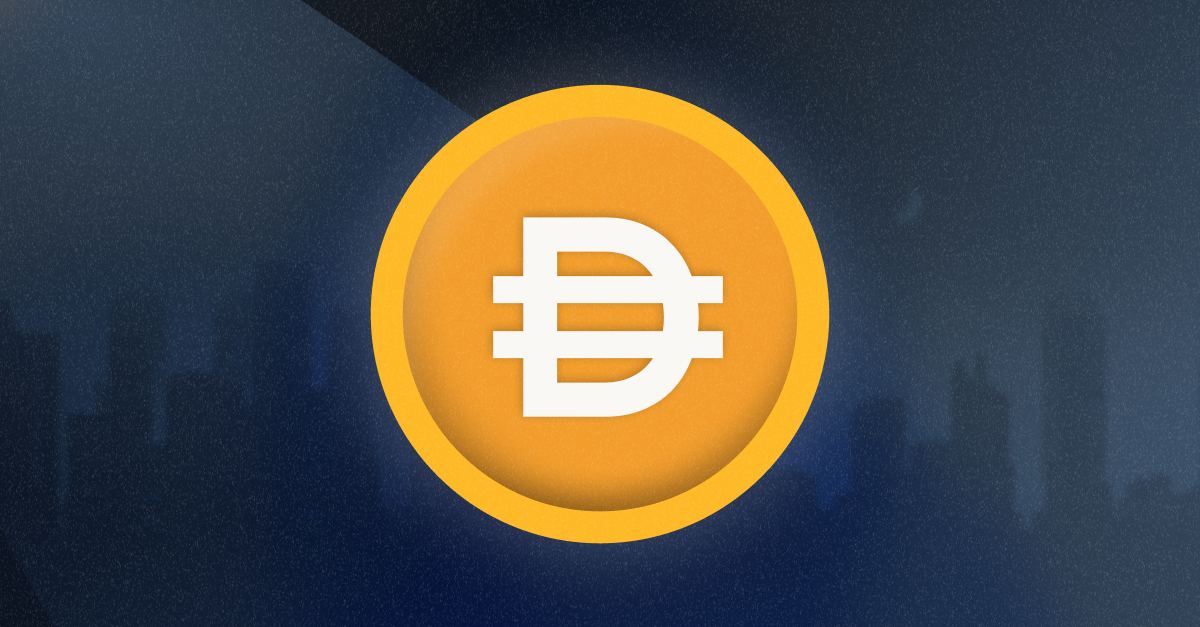We've all become acquainted with cryptocurrencies like Bitcoin and Ethereum. Some of us have dived into the crypto market, exploring and investing in various digital currencies, familiarizing ourselves with the array of options available. Crypto investors are often drawn to volatile cryptocurrencies with fluctuating values, but ultimately, many end up converting their funds into stablecoins via pools on decentralized exchanges (DEXs).
Have you ever wondered how stablecoins maintain their equal value to the dollar on a distributed ledger? USDT and USDC are two of the most talked-about stablecoins. These coins are not fully decentralized or algorithm-based, but they play a significant role in the cryptocurrency market. They are considered centralized because they are issued by specific authorities who ensure each coin is backed one-to-one by dollars, for which they charge a fee.
USDT, for example, claims to always be worth exactly one US dollar. However, there are some doubts about the actual cash reserves backing each USDT, as the issuer, Tether, sometimes lacks transparency in this area. On the other hand, USDC is known for its openness and regular audits of its dollar reserves. It's issued by Circle and Coinbase and also maintains a one-to-one value with the US dollar. Despite this transparency, the control over issuing and managing USDC remains centralized.
Now that we've briefly examined how centralized stablecoins operate, let's delve deeper into our topic.
What are Decentralized Stablecoins?
Unlike centralized stablecoins backed by assets like fiat, gold, oil, or real estate, decentralized stablecoins are algorithmic. No central authority backs or controls them.
Blockchain technology operates on a decentralized ledger, creating a natural demand for decentralized stablecoins. These coins offer an innovative solution in the cryptocurrency world. They combine the stability of traditional currencies with blockchain benefits. Decentralized stablecoins use algorithms and smart contracts to keep their value stable, no matter the external influences. Let's explore how these principles work and how they ensure stability.
Understanding MakerDAO: The Backbone of Decentralized Finance
In the vast landscape of decentralized finance (DeFi), MakerDAO stands tall as a pioneer, offering a unique solution to the volatility conundrum inherent in cryptocurrency markets. At the heart of MakerDAO lies a symbiotic relationship between two tokens: MKR and DAI. MKR, the governance token, empowers holders with voting rights, allowing them to actively participate in shaping the future of the MakerDAO ecosystem. On the other hand, DAI serves as a stablecoin, meticulously pegged to the value of the US dollar. But what sets MakerDAO apart is not just these tokens; it's the ingenious mechanism behind them.
The core concept revolves around maintaining the value of DAI in relation to the USD through a decentralized framework, achieved with the assistance of collateral and vaults - smart contracts that oversee collateralization.
Here's how it Works:
A user deposits ETH or ERC-20 tokens as collateral into a vault. Based on the collateral, the user can mint new DAI tokens. However, there's a catch - the system imposes a minimum collateralization ratio. For instance, if the minimum ratio is set at 150%, the user must have at least $150 worth of collateral for every $100 worth of DAI generated. If the collateralization ratio falls below the minimum (e.g., 150%), the user must either add more collateral or face liquidation.
Let's Illustrate this with an Example:
Imagine a user possesses 5 ETH, each valued at $200, totaling $1000. Assuming a minimum collateralization ratio of 150%, the user can generate a maximum of 667 DAI. However, for safety, the user decides to mint only 500 DAI, maintaining a comfortable collateralization ratio of 200%. In this scenario, the user secures their position, safeguarding against potential market fluctuations.
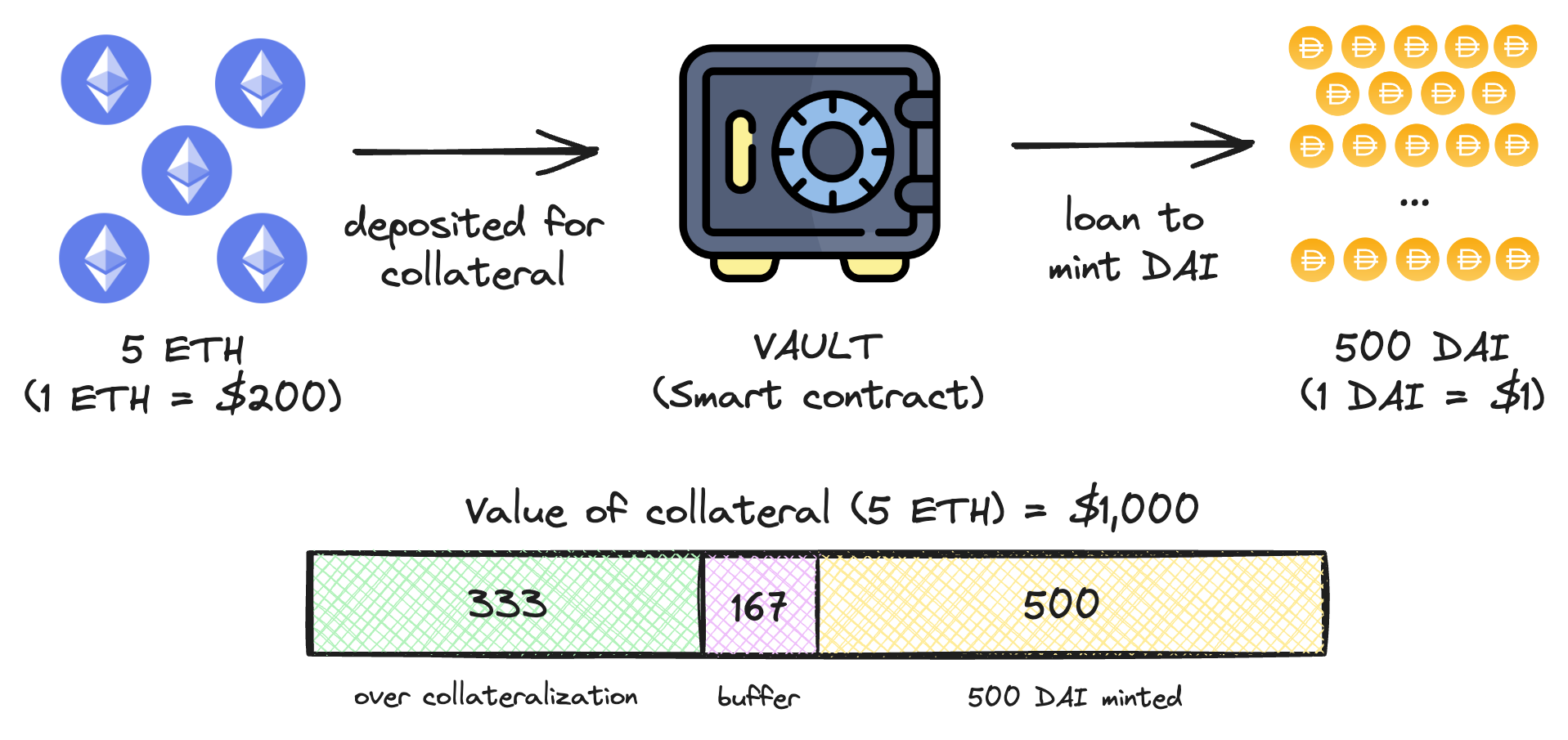
If the value of the collateral increases, the user can generate additional DAI tokens. The system mints an over collateralization buffer of 500 DAI. In our example, if the price of ETH rises to 300 USD, the user can generate an additional 250 DAI tokens (if they wish to maintain a 200% ratio).

On the other hand, if the value of the collateral falls to $500 (or below), the user can deposit additional collateral into the vault. The collateralization factor stands at 150%, allowing a maximum loan of 1,000 DAI, calculated by dividing 1,500 by 1.5. Another user, known as the keeper, can liquidate the contract. The actual loan amounts to 500 DAI, resulting in a collateralization ratio of 300%.
The keeper sells enough collateral to gather the DAI tokens needed to repay the vault. The keeper keeps a certain fee and returns the remaining collateral to the user's vault.
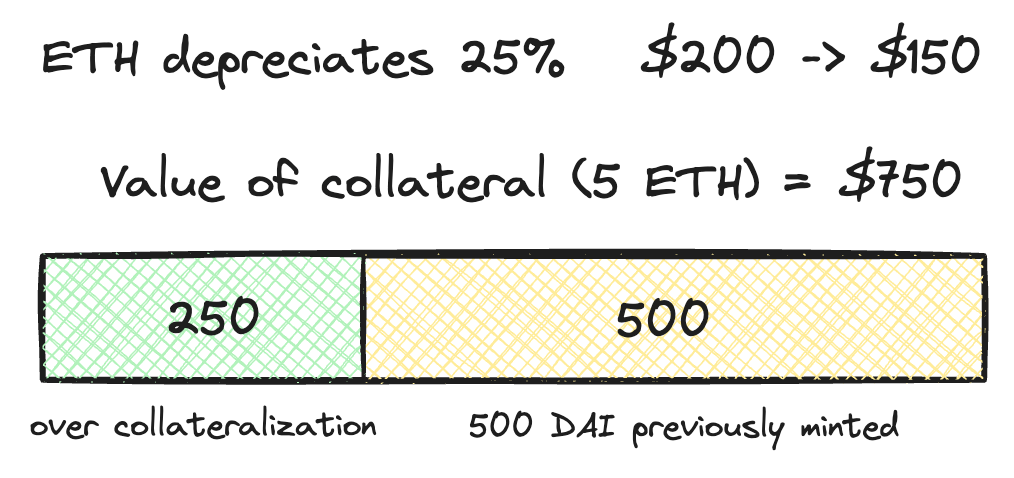
Conversely, if the price of ETH drops to $150, with the collateral now valued at $750 and the ratio standing at 150%, the keeper will sell 3.33 ETH for 500 DAI and return it to the vault. They will retain 0.2 ETH as a fee, while the remaining 1.47 ETH will be returned to the user's vault.
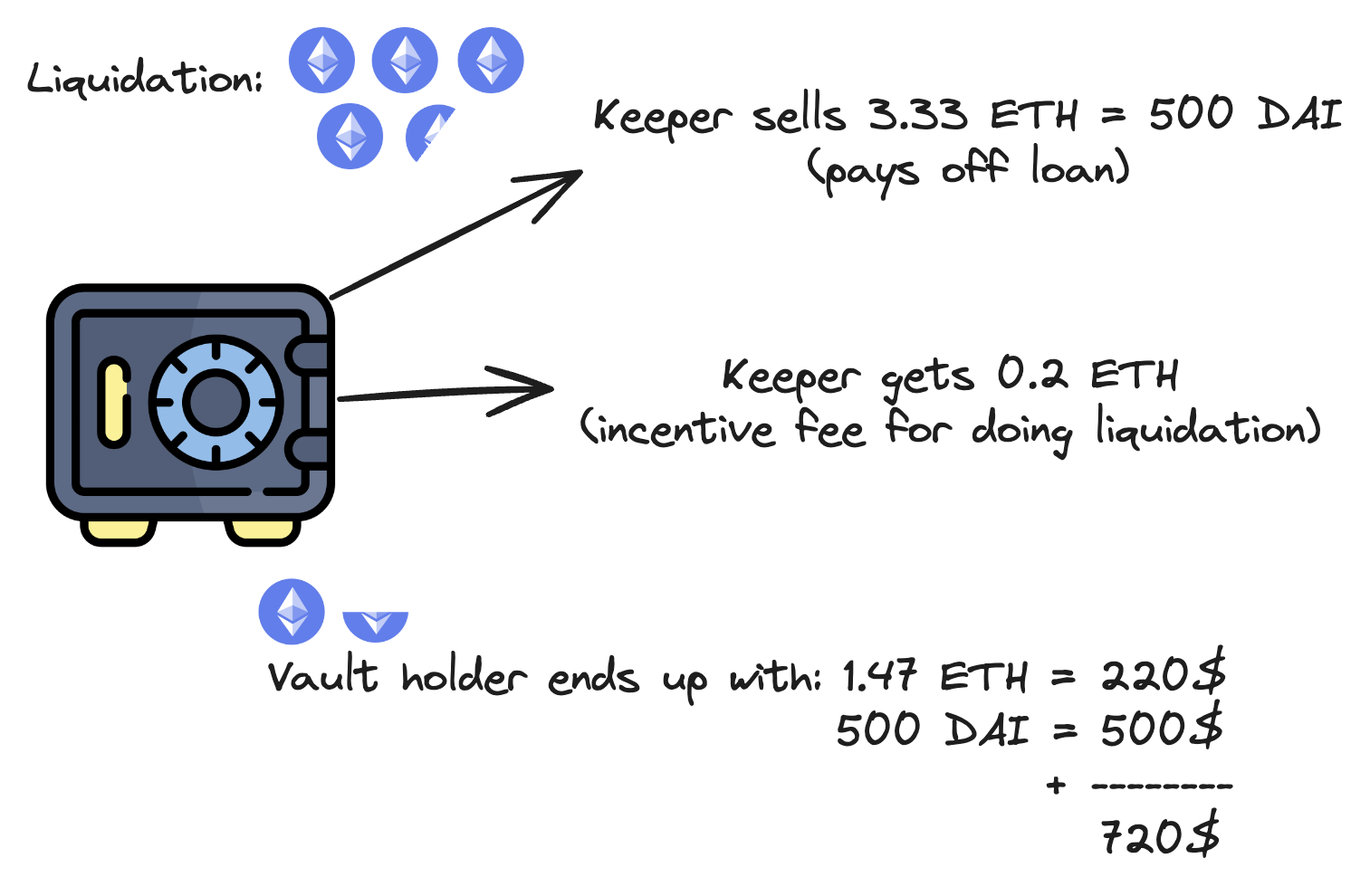
Ensuring Stability and Sustainability in MakerDAO
As MakerDAO continues to revolutionize the landscape of decentralized finance (DeFi), it uses various mechanisms to maintain stability and foster sustainable growth within its ecosystem. Let's explore these mechanisms:
- Stability Fee: This fee has a variable interest rate applies to all vault users who generate DAI tokens. It serves to regulate the DAI supply and is crucial for keeping its value stable relative to the pegged currency (USD).
- DAI Savings Rate (DSR): On the flip side, the DAI Savings Rate offers a variable interest rate that DAI token holders receive. To earn DSR, holders must deposit their tokens into a specific smart contract. Note that the DSR remains lower than the stability fee, motivating users to borrow DAI instead of holding it.
- Debt Ceiling: To prevent excessive expansion of the DAI supply, MakerDAO imposes a debt ceiling. This ceiling limits the maximum amount of DAI that one can generate in a particular vault, depending on the collateral type. This control helps keep the system within safe limits and protects against risks from too much issuance. If liquidation fails to cover the outstanding debt of DAI tokens, the system covers the shortfall using the collected stability fees. This mechanism keeps the system solvent even in adverse market conditions, bolstering confidence among users and investors alike.
Governance and Initiatives within MakerDAO
At the core of MakerDAO's decentralized governance model lies the MKR token, serving as the mechanism through which stakeholders influence the protocol's parameters and direction. Let's explore the role of MKR token holders and other participants within MakerDAO.
MKR Token Holders:
MKR token holders wield significant power within the Maker protocol. They actively participate in governance decisions, ranging from adjusting protocol parameters to voting on the distribution of surplus funds. In the event of a failure of debt repayment mechanisms, MKR token holders can mint new tokens and sell them to cover outstanding debts. However, this dilutes the ownership stake of existing MKR holders.
Additionally, in the event of system malfunctions or emergencies, MakerDAO has provisions for an emergency shutdown, ensuring the protection of user funds and the integrity of the protocol.
Motivations and Initiatives:
MKR token holders are incentivized to manage the platform effectively, as the value of their holdings correlates with the success and stability of MakerDAO. They have a vested interest in maintaining the integrity of the protocol and making decisions that foster long-term sustainability.
Keepers, on the other hand, play a vital role in the ecosystem by executing liquidations and earning fees for their services. Users also play a crucial role by utilizing the platform for various purposes:
- Users may choose to collateralize their assets (such as ETH) rather than selling them, anticipating future appreciation in value.
- They may leverage the platform to access additional liquidity, either by minting DAI against their collateral or utilizing financial leverage to increase their exposure to assets.
Maintaining the DAI-USD Peg:
To ensure the stability of DAI's peg to the USD, MakerDAO implements various strategies:
- If the price of DAI exceeds $1, users can lock additional collateral to mint new DAI tokens, subsequently selling them on the market. This increases the supply of DAI, driving its price back towards $1.
- Conversely, if DAI's price falls below $1, existing users may buy DAI from the market and return it to the vault reducing the supply. MakerDAO may also increase the stability fee to incentivize users to return DAI to the vault, thereby stabilizing its price.
Through these mechanisms, MakerDAO endeavors to maintain the stability and integrity of the DAI stablecoin, ensuring its usability and reliability within the broader cryptocurrency ecosystem.
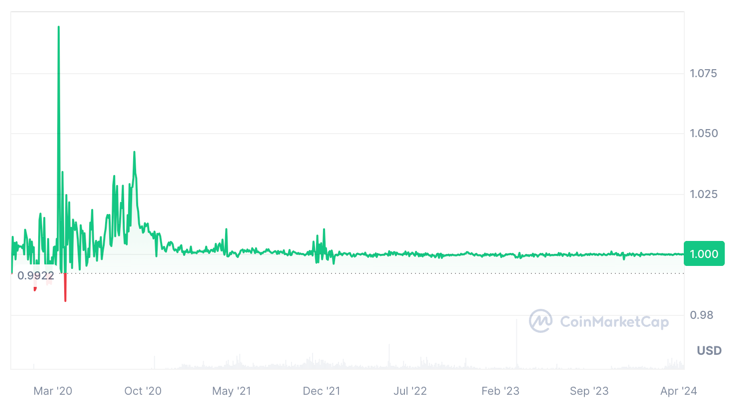
Conclusion
In conclusion, MakerDAO pioneers decentralized finance (DeFi) with innovative stablecoin solutions and governance. Through decentralized governance, empowered by MKR token holders, MakerDAO ensures protocol resilience. With collateralized debt positions and smart contracts, MakerDAO maintains DAI stability while fostering liquidity and risk management. Incentivizing responsible participation and upholding the DAI-USD peg, MakerDAO commits to stability and sustainability. Leading DeFi with collaboration and innovation, MakerDAO sets standards for decentralized governance and stablecoin mechanisms, shaping finance's future.
Software engineer
If you like this article, we're sure you'll love these!
Smart Sensor - Case Study
Read all about how we reinvented the Smart Building Industry using our IOT, design and development expertise.
Building Cross-chain DApps with Hyperlane
The Hyperlane protocol allows us to develop cross-chain DApps using their permissionless interoperability layer. Read more to see how it works across various blockchain environments.
